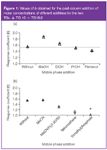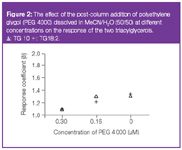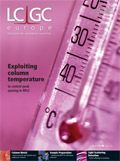Factors Affecting Sensitivity of Evaporative Light Scattering Detection
LCGC Europe
An evaporative light scattering (ELS) detector is a powerful detection tool if the solutes are less volatile than the eluent. Three main processes occur successively: nebulization, evaporation of the liquid chromatographic (LC) effluent and measurement of the light scattering by the residual particles. This leads to a non-linear calibration curve such as, A= a.m b where A is the peak area,m the sample mass and b the response coefficient measured as the slope of Log A = b>Log m + Log a.
An evaporative light scattering (ELS) detector is a powerful detection tool if the solutes are less volatile than the eluent. Three main processes occur successively: nebulization, evaporation of the liquid chromatographic (LC) effluent and measurement of the light scattering by the residual particles. This leads to a non-linear calibration curve such as, A = a.mb where A is the peak area, m the sample mass and b the response coefficient measured as the slope of Log A = bLogm + Log a.
The goal of this paper is to demonstrate that ELS response is similar to ultraviolet (UV) or fluorescence (F) detection and can be modified by adjusting certain parameters.
For triacylglycerol (TG) analysis, we show that we can alter the b value by modifying the nature of the mobile phase by post-column addition. It was found that b greatly varies (from 1.89–1.02) depending on the nature of the added compounds. Solvents that favour interactions that modify the particle size distribution of the three diverse aerosols characterizing the three processes were chosen as added compounds. This allows the value of b to be monitored in direct relation with the scattering particle size as predicted by theory that b should be between 0.66 for big particles to 2 for small particles of the Rayleigh domain.

In the field of liquid chromatography (LC) detectors, the evaporative light scattering (ELS) detector is becoming more popular and can be considered as a quasi-universal detector as long as the solutes are less volatile than the LC eluent.1,2 The response is determined by

where A is the peak area, m the sample mass, a and b are numerical coefficients that depend on droplet size, concentration and the nature of solute, gas and liquid flow-rates, molar volatility, and so on.
The response coefficient b values listed in the literature are between 0.9–1.9 which results in non-linear calibration curves (b1) and corresponds to the slope of

The goal of this paper is to demonstrate that ELS response is similar to UV or fluorescence (F) detection and can be modified by adjusting certain parameters.
Ultraviolet (UV) detection depends on the selected wavelength of absorption (which is related to the chromophore of the solute to be analysed) and may be compromised by the mobile phase absorption, which must be low at this wavelength. Evaporative light scattering detection (ELSD) is easy when there is a large difference between the mobile phase volatility and the solute volatility. Consequently, the possibility of evaporating the mobile phase at low temperature allows the analysis of semi-volatile compounds with non-volatile compounds. The wavelength choice for UV detection corresponds to the drift tube temperature chosen to evaporate the mobile phase in ELSD. The performance of ELS detectors, like UV detectors, depends on the model and manufacturer.
UV or ELSD can analyse a wide range of compounds and may be more sensitive when the appropriate parameters are optimized. These factors can be divided into three different categories: instrumental parameters, such as the characteristics of the UV cell or ELSD nebulizer and eluent flow-rate; solute properties, such as chemical derivatization or transformation by complexation; and LC separations conditions, such as the nature of the mobile phase.
In the first set of parameters, the UV cell design influences background noise, signal intensity via the cell length, geometry and volume, so the UV response depends on these parameters.3,4 For a given wavelength, the response factor (RF) is lowered with a cell length and volume decrease. Such a decrease is compensated by an increase in the solute concentration at the top of the peak when capillary chromatography replaces conventional chromatography. So, for an amino acid analysis, Barrett et al. observed an increase in signal to noise ratio (S/N) and a decrease in the limit of detection (LOD) with a decrease in internal column diameter with a UV detector,5 but such an increase is more important for the ELSD than for the UV detector. Our interpretation of this result, which highlights ELSD, is mainly based on the following considerations: It is easier to evaporate low quantities of solvent and additive. In these analysis conditions the semi-volatile ion-pairing agent represents the major component of the background noise and the quantity to evaporate decreases with the mobile phase flow-rate.
Explanations for the ELS signal and S/N increase in capillary chromatography may result from the increase in the solute concentration that directly induces an increase in the droplet size of the scatterer as published by Chaminade et al.6 This explanation agrees with a decrease in the b value that goes towards the unit.6 Consequently, in capillary chromatography a direct linearity may characterize the ELS response as:6–10

Chemical derivatization is the second category that strongly modifies the detector response and signal intensity.11 With UV detection, off-line and on-line derivatization may transform a non-UV-absorbing solute into a UV-absorbing solute and also assist solute detection.12 Currently, in ELSD the solute transformation is not commonly practised, even though it was clearly mentioned in the first paper in 1966.13 However, the modification of the mobile phase pH is the classical parameter used to make ELSD of basic compounds easier because ionization reduces the compound's volatility.
Also, in a paper published in 2004, two different solute complexations using a post-column on-line complexation of triacylglycerols were reported.14 One corresponds to the formation of a cholesterol–TG complex, which increases the particle size of scatterer compared with the non-complexed TG or associated TG. The other corresponds to a 1/1 TG–Ag+ complex, which avoids solute association between solute as well as solute–mobile phase association. As expected, an increase in the scatterer size decreases the b value (b decreases from 1.3–0.6 with diverse cholesterol concentrations) while a decrease in the scatterer size does increase the b value (b increases from 1.3–1.8). This shows the importance of the particle size of the scatterer and the consequent variations in the b values.
As mentioned in a paper by Engelhardt and Schultz,15 we do not know what the detected particles are (i.e., what is the nature of the scatterer in the tertiary aerosol?) Dry particles, wetted particles of bare solute or of associated solutes? Factors such as mobile phase nature and evaporation temperature of the drift tube may have a strong influence on the scattering particles.6,16,17 Recently, Chaminade shows a response enhancement in ELSD of diverse compounds with a triethylamine–formic acid additive to the mobile phase.18,19 The proposed mechanism involves a "cluster formation" which changes the b value slightly and the a value in equation 1 strongly. Such a result was also observed with a triethylamine–trifluoroacetic acid mixture added to the mobile phase to determine anions using LC–ELSD.20
In this paper, we report changes in the aerosol distribution (primary aerosol) or in the tertiary aerosol (the scatterer) using an on-line post-column addition after a chromatographic separation. Some modification of the mobile phase properties, such as viscosity and surface tension, when using PEG 4000 at micromolar concentrations may change the aerosol size and droplet distribution. A specific property of other solvents used in the mobile phase may influence the size of the scatterer and droplet size distribution of the primary aerosol. Another way consists in using molar concentration of a solvent of specific properties that may influence the size of the scatterer. Triacylgycerols (TG) were chosen as molecular model to involve specific interactions with molar concentration of solvent, which differ from the mobile phase constituents.
Experimental Data
Chemicals: TGs [tricaprin (TG 10) and trilinolein (TG 18:2)] were obtained from Sigma (Saint-Quentin Fallavier, France). Acetonitrile (MeCN) [Acros, Noisy le Grand, France], methylene chloride (CH2Cl2), methanol (MeOH) [Carlo Erba, Milan, Italy] and water (H2O) [SDS, Peypin, France] were of high performance liquid chromatography (HPLC) grade. Pentanol and nitropropane were purchased from Merck (Darmstadt, Germany); ethanol (EtOH) and isopropanol (iPrOH) from Prolabo (VWR international, Fontenay-sous-bois, France); trimethylphosphate (TMP) and polyethylene glycol (PEG) 4000 from Fluka (Buchs, Switzerland).
Equipment: The chromatographic system consisted of a Model 1050 pump (Hewlett-Packard, Palo-Alto, California, USA), a Model 7125 injection valve with a 20 µL loop (Rheodyne, Cotati, California, USA) and a Model Sedex 75 light-scattering detector (Sedere, Alfortville, France). The nebulizing gas was air at 3.6 bars (corresponding to a flow-rate of 1.92 L/min), the nebulization temperature was 37 or 55 °C, according to the solvent post-column used, and the gain (PM) was maintained at 11. Chromatograms were recorded with Azur (v 3.0) acquisition software (Datalys, Saint-Martin d'Heres, France).
The column temperature was controlled using an Igloo-cil oven (Cluzeau, Sainte-Foy-la-Grande, France) and set at 20 °C.
A Kromasil C18 (5 µm) 150 mm × 4.6 mm column was used (Touzart and Matignon, Les Ulis, France). The mobile phase flow-rate was 1 mL/min.
For the post-column addition, a model 114 M pump in micro mode (Beckman, Gagny, France) and a pulsation damper (Touzart and Matignon) were used and connected between the column output and the ELSD nebulizer via a polyether ether ketone (PEEK) tee in which the main flow comes from the orthogonal branch of tee and the added flow from the top branch of tee. The post-column addition flow-rate was 50 µL/min and such a device allows good mixture of the two flows.
Methods: The mobile phase composition MeCN/CH2Cl2 (65/35) was chosen to give moderate retention times for the TGs.21 For TG 10 and TG 18:2 the retention factors were 1.9 and 6.4 respectively.
The TGs were dissolved in MeCN/CH2Cl2 (50/50). The calibration curves were established using between five (range 5–40 ppm) and eight (range 5–100 ppm) different TGs concentration levels. The difference in the calibration ranges was a result of the saturation of the signal with some of the post-column solvent.
We found that irrespective of the number of concentration levels [i.e., (5–100) or (5–40) ppm], the b value was the same. Each area value was the average of three reproducible injections. To avoid modification of the solutes retention, the tested solvents were added using a post-column addition, using a polyether ether ketone (PEEK) tee.
The post-column addition flow-rate was maintained at 50 µL/min — corresponding to a slight increase in the mobile phase flow-rate (5%).
Results and Discussion
Studies without post-column addition: First, the study of peak area versus the amount of injected TGs was made without post-column addition. The mean b value was 1.5 (1.48–1.55 for TG 10 and 1.45–1.54 for TG 18:2), showing no significant difference between the two compounds. As previously reported, the b values are closed for compounds belonging to only one chemical family (library).1 Normal b values for NARP are generally higher than 1.5 while in aqueous liquid chromatography (LC) b values lower than 1.5 are commonly reported.1 According to theory, a low b value is consistent with a big particle size scatterer. So, the low b value (1.5) means that the tertiary aerosol is not composed of "dry" solutes but composed by "wet" solutes (i.e., by particles bigger than particles of dry solutes).15,22
Studies with post-column addition of molar concentration of different compounds: The study of peak area versus the amount of injected TGs was performed with post-column addition of four different alcohols. The same observations can be made about the two TGs:
When the post-column addition is made of alcohols of increasing carbon atom number (MeOH, EtOH, iPrOH, Pentanol), the b value decreases [Figure 1(a)].

Figure 1With post-column addition of methanol, a common b value (1.8–1.9) is observed. When the b value decreases, log a increases (results not shown) as noted before.17,22,23 These results can be linked to the variations of the interactions between the solute (TG) and alcohol: interactions between alkyl chains of the solute (TG) and the alcohol increase with the alkyl chain length of the alcohol and an increase in the resulting particle size contributes to the decrease of the b value. Moreover, the different volatilities of added alcohols may modify the size of the alcohol–TG aggregate.
With MeOH, the b value agrees with the dry solute particles produced in the tertiary aerosol. The same study and the same observations have been made with other additives: b values are lower than 1.55 (the b value obtained without post-column addition) [Figure 1(b)].
This corresponds to differences in solute–solvent aggregation. It demonstrates a solute "wetting" dependent of the additive nature. The differences in b values correspond to solute–solvent interaction variations that directly influence the tertiary aerosol nature, as well as size distribution.
Studies with post-column addition of micromolar concentrations of PEG: The study of peak area versus the amount of injected TGs was performed with post-column addition of PEG 4000 dissolved in MeCN/H2O (50/50). The b values obtained are shown in Figure 2. PEG 4000 is known to change physical properties of water, particularly viscosity and wettability.24

Figure 2
A miscible ternary phase composed of MeCN/CH2CI2/H2O was obtained by dissolving the PEG 4000 in MeCN/H2O (50/50). Without PEG 4000 (0 µM), the b value decreases from 1.5 [Figure 1(a) and 1(b), without] to 1.3 [Figure 1(b), MeCN/H2O (50/50)]. Such a decrease corresponds to some interactions caused by the water content.
With the addition of PEG 4000 at 0.3 ×10-6 M (corresponding 4 ppm w/w), the b value decreases more strongly, tending towards 1, showing the specific effect of the polymer. The presence of PEG 4000 and water leads to a mobile phase, which spreads over the solutes better, making bigger and more stable (solute–solvent) aggregates. For PEG 4000 with smaller concentration (0.16 × 10-6 M), the b value goes up, leading to conclude that there is not enough polymer in the solution to modify the viscosity and/or the wettability as well as the maximum amount of interactions with the solute.
An explanation for this behaviour may be that the nebulization process is affected by the presence of polymers in the solution, because of change in the viscosity. At different analyte concentrations the mean droplet size may be different, giving rise to a different number of particles. Moreover, the efficiency of the transport of droplets through the evaporation chamber may depend on their mean size.
When the b value decreases, the peak width increases (ω½ = 0.15–0.17 with TG10; ω½ = 0.27–0.34 with TG18:2). As demonstrated by Guiochon 21 years ago,25 this result is in agreement with the standard deviation σ corresponding to a Gaussian curve in ELSD.
We may conclude to a b variation given by a micromolar compound addition that modifies the primary and the tertiary aerosol produced in an ELS detector. Such a micromolar concentration of solvent added to the output of the column cannot modify the b value while, as we have seen previously, some molar solvent addition will produce an important b variation.
Conclusions
These results agree with previous research showing that the sensitivity of the ELS detector depends on the nature and concentration of the additive,17,18,20,23,26 as well as the instrument settings.17,26,27 Some variations may be a result of the presence of very low concentrations (micromolar level) of additive and may explain the lack of reproducibility of some of the results obtained from an ELS detector. When small quantities of impurities in a solvent alters solute–solvent interactions the b slope or the log a value may change, as well as the reproducibility.
Currently, there is no specific grade of solvent purity for ELSD but further investigation into this is required to obtain better reproducibility and/or a better limit of detection. The dependency of the parameters a and b was mentioned earlier by Guiochon17 and confirmed recently by Chaminade,22–23 Lane et al.,28 and our own unpublished results.
A decrease in b is "compensated" by an increase in a or log a, so we may conclude that these parameters are not independent.29 These results offer a new approach for ELSD quantitative analysis.30
Sylvie Héron is assistant professor of analytical chemistry in the Group of Analytical Chemistry of Paris Sud (LETIAM) at the University of Paris Sud (IUT Orsay). Her current research interests include development and optimization of LC methods for lipids analysis with Evaporative Light Scattering Detector and Mass Spectrometry.
Michel Dreux was a professor in separation sciences at the Institute of Organic and Analytical Chemistry of the University of Orleans, France. He was at the head of the Analytical Research Group. His main research interests concern chromatography, capillary electrophoresis and capillary electrochromatography. He is now the Scientific Director at SEDERE.
Alain Tchapla is professor of analytical chemistry in the Group of Analytical Chemistry of Paris Sud (LETIAM) at the University of Paris Sud (IUT Orsay). He is head of the LETIAM research group. His main research interests concern chromatography, mass spectrometry and liquid stationary phases caracterization.
References
1. M. Dreux and M. Lafosse, In Carbohydrate Analysis, Z. El Rassi, Ed (Journal of Chromatography Library, Vol. 58, Elsevier, Amsterdam, 1995) pp. 515.
2. J.M. Charlesworth, Anal. Chem., 50, 1414–1420 (1978).
3. A.M. Krstulovic, P.R. Brown, In Reversed-Phase High Performance Liquid Chromatography: theory, practice, and biomedical applications, (J.Wiley and sons, New York, 1982, chap. III.) pp. 32.
4. J.N. Done, In High Performance Liquid Chromatography, C.F. Simpson, Ed, (Heyden and Sons Ltd, London, 1978) pp. 79.
5. Z. Cobb et al., J. Microcolumn Separations, 13(4), 169–175 (2001)
6. K. Gaudin et al., 17th International Symposium on Microscale Separations and Capillary Electrophoresis, Feb 8–12, 2004 Salzburg, Austria, poster P 176.
7. S. Héron and A. Tchapla, J. Chromatogr. A, 848, 95–104 (1999).
8. M.B.O. Andersson and L.G. Blomberg, J. Microcol. Sep., 10, 249–254 (1998).
9. R. Trones, et al., J. Chromatogr. A, 814, 55–61 (1998)
10. J.N. Alexander IV, J. Microcol. Sep., 10, 491–502 (1998).
11. T. Toyo'oka, Ed, Modern Derivatization Methods for Separation Sciences, (J.Wiley and Sons, Chichester, 1999) pp. 233.
12. K. Zaitsu, M Sai and K. Hamase, In Derivatization Methods for Separation Sciences, T. Toyo'oka, Ed, (Wiley and Sons, Chichester, 1999) pp 64.
13 D. L. Ford and W. Kennard, J. Oil Colour Chem. Ass., 49, 299–304 (1966).
14. S. Héron, M. Dreux and A. Tchapla, J. Chromatogr. A., 1035, 221–225 (2004).
15. R. Schultz and H. Engelhardt, Chromatographia, 29, 517–522 (1990).
16. G. Guiochon, A. Moysan and C. Holley, J. Liq. Chrom, 11(12), 2547–2570 (1988).
17. M. Righezza and G. Guiochon, J. Liq Chrom. 11(9–10), 1967–2004 (1988).
18. K. Gaudin et al., J. Liq. Chromatogr., 23, 387–397 (2000).
19. F.S. Deschamps et al., Chromatographia, 54, 607–611 (2001).
20. C. Elfakir, P. Chaimbault and M. Dreux, J. Chromatogr. A, 829, 193–199. (1998).
21. S. Héron, J. Bleton and A. Tchapla, In New Trends in Lipid and Lipoprotein Analysis, E.G. Perkins and J.L. Sébédio, Eds, (American Oil Chem. Soc. Press Publ., Champaign, Illinois, USA, 1995) pp.205
22. F.S. Deschamps, P. Chaminade, A. Baillet, The Analyst, 127, 35–41 (2002).
23. K. Gaudin, A. Baillet and P. Chaminade, J. Chromatogr. A,1051, 43–51 (2004).
24. D. Bonn, V. Bergeron and L. Vovelle, La recherche, Mars, 3, 40–43 (2002).
25. A. Stolyhwo et al., J. Chromatogr., 288, 253–275 (1984).
26. H. Gangloff et al., US Pending Patent 10/167, 820 (2002).
27. H. Gangloff et al., French Patent n° 01 09 202 (07-11-2001)
28. S. Lane et al., 25th International Symposium on Chromatography,
4–8 October 2004, Paris, France, Poster.
29. S. Héron et al., LC•GC Eur, 19, 664–672 (2006).
30. S. Héron et al., J. Chrom. A, accepted 2007.

New Study Reviews Chromatography Methods for Flavonoid Analysis
April 21st 2025Flavonoids are widely used metabolites that carry out various functions in different industries, such as food and cosmetics. Detecting, separating, and quantifying them in fruit species can be a complicated process.














